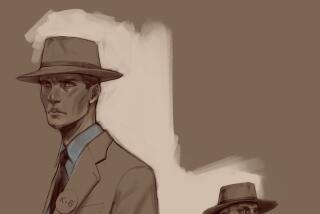Star Vehicles
- Share via
In Steven Spielberg’s “Minority Report,” set in Washington, D.C., circa 2054, the cars offer a not-so-far-out peek into the automotive future. They travel vertically as well as horizontally on a magnetic track and feature video interaction via holographic projections and a DNA recognition entry and ignition system.
They’re the vision of Harald Belker, who is fast becoming Hollywood’s go-to vehicle designer. He created the sleek, ominous Batmobile for “Batman & Robin” (1997), the whacked-out Lincoln Continental for “Inspector Gadget” (1999) and the space shuttle in “Armageddon” (1998). He also tricked out Vin Diesel’s macho GTO for the upcoming summer action movie “XXX.”
But souped-up and eye-catching as the cars might be, Belker designs them to blend in with the rest of the movie. “I design vehicles that stand out but are in character,” he says. “They help the feel of the film.” With “Minority Report,” which opened Friday. Belker’s automotive universe underscored the film’s surreal yet strangely familiar visual landscape.
When Belker first heard about “Minority Report,” loosely based on a short story by sci-fi novelist Philip K. Dick, he sensed that the project “was my ticket.” Before production started, Spielberg assembled a think tank of scientists, environmentalists, urban planners and writers to create a vision of the future. The resulting cinematic world merges present-day Washington, D.C.--including traditional touchstones such as the Washington Monument--with visionary technology, including a mass-transportation system that operates via magnetic levitation.
Belker collaborated with “Minority Report” production designer Alex McDowell (Fight Club,” “The Crow”) to devise the intricacies of the so-called Mag-Lev system. “A lot of designers draw up ‘picture vehicles’ without thinking how the cars work,” McDowell says. “Harald designs from a real-world stance. He combines his knowledge of mechanics to produce functional, aesthetic models.”
The Mag-Lev system transports brake- and wheel-less “pods” along a vertical-horizontal roadway made of magnetic discs. Belker created Tom Cruise’s computer-controlled, voice-activated “pod” that zips along the tracks accident-free. According to Spielberg, “The most futuristic thing about the movie, and maybe the most science-fictiony thing, is the look of the Mag-Lev systems.”
Says Belker: “The real problem was figuring out how to get a vehicle from a flat surface to go vertical, along buildings. We didn’t want flying vehicles, like ‘Blade Runner.’ It had to make sense, with form following function.”
McDowell says that they labored to avoid any comparisons with Ridley Scott’s groundbreaking sci-fi film, also based on a Dick story. “When you’re doing an urban-based future film, it’s hard to avoid ‘Blade Runner’ because it’s always going to be a classic,” he says. “But ‘Minority Report’ goes in a different direction. It imagines more of a utopian future in a green, non-post-apocalyptic world.”
During production, Spielberg decided to add a twist in which Cruise’s character leaves the Mag-Lev, fleeing his pursuers by driving to the country. Belker rejected the idea of a Mag-Lev pod going “off system.” Instead, working with McDowell, Belker sketched out plans for another type of vehicle. He designed the so-called “hero car”--a snazzy red two-seater coupe--in just three weeks. After getting Spielberg’s approval and running it by the designers at Lexus’ Southern California design studio--the car company’s logo appears on the vehicle--Belker turned it into reality.
A computer converted the sketch into a 3-D model. CTEK, a Tustin technology development company, used the prototype to build the electric-powered car in four months. “The design came from a police car I had done, an early model, with rugged wheels,” he says. “I integrated that into a sports car concept. It’s very raw and different in proportion.”
The car makes its first appearance when it emerges, with Cruise inside, from the computer-activated factory that produces it. The car’s appearance is deceiving. Indeed, when Lexus began to display it at car shows, the extreme cab-forward design fooled many observers. “People say they don’t know which way it goes,” Belker says. “To me, I always knew where it was going. The car always leaned forward, so all the lines go forward.”
In imagining the future, Belker also created a “wow” car, one that virtually drives itself. Among the features: laser-guided cruise control, a carbon fiber and titanium composite chassis, retinal scan entry and a weather-sensitive response system (with tire tractions that adjust automatically to road conditions).
When he drafted the voice-activated, computer-controlled system, Belker curtailed the car’s interior architecture. That left Cruise with little to do, so Belker added screens and other doodads. “It’s funny--you think future, so you minimize everything,” he says. “But I forgot about the actors.”
Belker is vague about the cost of building the cars. “It was more than $100,000 and less than $1 million,” he says.
Drawn to Auto Design
Born and raised in Dusseldorf, Germany, Belker came to the United States in 1984 on a tennis scholarship at Georgia Southern University. A friend showed him a magazine article about automotive design, and Belker’s future was sealed. “We were always talking about how cool it would be to design cars,” he says. “I never thought you could go to school for that.”
Belker, now 41, enrolled in Art Center College of Design in Pasadena, graduating in 1990 with a degree in transportation design. He then worked for Porsche in Germany, where he experienced “culture shock,” before deciding to return to Los Angeles. Mercedes-Benz hired him for its Smart Car project at the company’s advanced design studio in Irvine.
After four years, Belker quit to freelance. “When you come out of school, you think you can change the industry,” he says. “It takes about a year before you realize that you can do nothing. I didn’t want to become a manager; I just wanted to be the one who draws and comes up with new ideas.”
Belker, who retains a slight German accent, talks in the airy living room of the Santa Monica townhouse he shares with his wife. Dressed in jeans and a gray T-shirt, he folds his 6-foot-7-inch frame into one of two sleek chairs that he designed. His own two cars--a Porsche Boxster and an Audi A6--are stored in the garage. “I like to drive fast,” he says, shrugging.
After leaving Mercedes-Benz, Belker worked as a consultant for several car manufacturers. In 1998, former Chrysler head Lee Iacocca selected Belker to design an electric bicycle for his North Hills-based company EV Global.
“It was a difficult styling job because electric bikes have so little room” for design elements, Iacocca recalled in an interview last week. “Harald did wonders; he put together a slick, hot package of industrial engineering.”
Belker enjoyed the project but left because sales for the bike weren’t taking off. Anyway, by then Belker sensed that his future was in Hollywood. “Batman & Robin” production designer Barbara Ling was the first to call, hiring him for the fourth film in the series. He designed the ice truck for Mr. Freeze (played by Arnold Schwarzenegger), as well as the over-the-top Batmobile. “It was lavish, the more outrageous the better,” he says. “The whole thing grew to 28 feet long, as a single-seater, and then the director added big wings to the sides.”
The Freedom of Film
After “Batman,” he worked on “Armageddon,” “Inspector Gadget,” “Battlefield Earth” and “Spider-Man,” joining a small cadre of car designers who chose entertainment over engineering. “Working in film allows the designers to be more creative and less pragmatic,” says Ron Hill, former chairman of Art Center’s transportation design department. “When you work for Porsche, your goal is to produce a consumer product. In Hollywood, your goal is creative response realized once.”
As he awaits the release of “XXX,” Belker and McDowell are beginning to collaborate on their next project: Dr. Seuss’ “The Cat in the Hat,” starring Mike Myers and directed by Bo Welch.
“In this case, the idea was to create the most stupid car you could imagine,” McDowell says. “It has to look silly, awkward, nonaerodynamic. It goes against every grain in Harald’s body.”
Belker says he’s enjoying the crooked ride.
“There’s not a straight pipe in Dr. Seuss,” he says. “It’s very trippy and weird. That’s what my world is like right now--all bent out of shape.”






